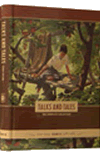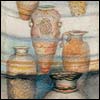Rabbi Isaac Luria has become famous as the "Ari," the holy lion; Ari represents the initials of “Ashkenazi Rabbi Isaac” As his name indicates, his family originally lived in Germany, whence they had wandered to Jerusalem. There the man was born who was to play a magnificent role not only in that century of spiritual and cultural revolutions, but down to our very days.
At a very early age Rabbi Isaac Luria lost his father and he went to Cairo, Egypt, where Mordecai Frances, the rich brother of his mother took care of his upbringing and education. He attended the Yeshiva of Rabbi David ben Zimri, the Chief Rabbi of Egypt, known as the author of many great commentaries and responsa under the name of Radbaz. The brilliant youngster became one of the close disciples of the Radbaz, and his studies of the Talmud early promoted him to heights of scholarly achievements. The only extant product of his work in Gemara and Halachah, is a commentary to Zevachim. When Rabbi Mordecai Frances saw the great success of his young nephew, he gave him his daughter as a wife and assured him of sufficient means for a livelihood.
Yet the deep and introspective nature of Rabbi Isaac Luria was not satisfied by the study of Halachah alone. He acquired knowledge of Cabbala and devoted his entire life to its study and dissemination. At an early age he began his long stays in the solitude of the Nile River. For seven long years he lived all by himself, immersed in the study of the "Zohar," the main work of Cabbala, and other minor Cabbalistic writings, and returned only once a week, on Shabbos, to his family in Cairo. Possessed of a fiery and noble soul, he was wholly attracted to the universe of deeper wisdom and sought the meaningful interpretation of all phases of life, nature, and prayer. He spent many days in fast, prayer and study. In his tireless efforts to penetrate the inner chambers of the Torah, he discovered much of the true meaning of the Jewish faith. He was able to work out a whole system of a Cabbalistic doctrine on the world, and on the role of the Torah and its commandments in the life of man.
Filled with the fire of inspiration and enthusiasm, he set out to cleanse the world of the spirit of impurity and to replace the rule of evil by the recognition of G‑d. About the year 1569, he took his family and migrated to Jerusalem and from there to Safed, the center of all study and practice of Cabbala. Soon a large group of disciples gathered about him and listened to his interpretations of the deeper meaning of all happenings and occurrences in the world. More and more men flocked to him and accepted the tenets of a holy and ascetic life which the Ari Hakodosh set down as a necessary requirement for participation in the circle of his followers. Under his inspired guidance, prayer assumed a deeper meaning, since the significance of each word and phrase was interpreted by him. The fast days and holidays turned into genuine turning points of religious life, and the Shabbos became the pivot of holy experience and inspiration, for it was devoted exclusively to spiritual activity. Each Sabbath meal, filled with songs of holy content, many of them written and composed by the Ari Hakodosh himself, was an offering to G‑d, and the Melaveh Malkeh represented a stirring tribute to the departing Sabbath.
In such and similar manner, most aspects of the Jewish life and faith were given new content and color. Rabbi Isaac Luria's teachings were spread wide and far and reached all corners of the world, wherever Jews had settled. Amongst the most ardent exponents of the Ari's teachings was his disciple and successor to the leadership of the Cabbalists, Rabbi Chaim Vital. Rabbi Chaim Vital recorded the revelations and explanations of his great master, and they were among the most printed books in those early days of the printing press. Another ardent disciple and exponent was Rabbi Israel Saruk.
Rabbi Isaac Luria's personality inspired all the great men who had penetrated deeper than most mortals, into the world of Cabbala. The Ari died at the age of thirty-eight years, mourned by the entire Jewish people. Despite his short life, he left an indelible impression on religious Jewish life and religious reaching. He introduced many holy Minhagim (customs) which have become part and parcel of our customs and services. His songs and prayers have been widely adopted and partially incorporated into the Siddur. Entire communities guide themselves by the "Nusach HoAri" and much of his teachings has been used to form the basis of the great Chassidic movement. Due to his influence and inspiration Judaism was able to withstand the onslaughts of many creeds and ideas that were promoted during the sixteenth and seventeenth centuries. He certainly counts among the holiest and most important leaders of the Jewish people.
















Join the Discussion